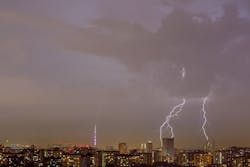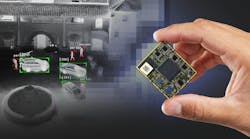On average, there are 25 million cloud-to-ground lightning strikes per year, lightning hits earth 100 times per second, and there are 1,800 thunderstorms on earth at any given moment. And it only takes one lighting strike, either from a thunderstorm or other natural disaster, to ruin thousands of dollars of security equipment.
Sudden, severe voltage surges like those from lightning can cause almost immediate and total failure of security equipment. However, even small power voltage surges can deteriorate sensitive circuitry over an extended period of time.
Internal surges can result when a single piece of equipment with a large power draw is turned on, and externally via a disruption in service from the grid itself. In either case, the timing of the disruptions can come at any hour of the day. Power spikes can also easily enter data/telecom lines (i.e. phone, cable or satellite systems, local area networks [LAN], etc.) just as they can electric power lines.
In any of these scenarios, there can be substantial costs involved due to the physical damage of security systems. But from a business perspective, the potential loss of data and downtime could be far greater. Facilities must be evacuated when the fire alarm systems stop functioning. When security systems are out of service, parking lots, doors, and secure areas need to be covered by temporary security officers at an additional cost. There is also a loss of productivity if staff is delayed by congestion and manual processes at entrances, or if their work equipment and/or work data is damaged or lost. Downtime can also cause a potential loss of customer confidence or business. If a customer uses social media to complain about a website being down for a few hours, the resulting negative impact can be detrimental to a business for an extended time.
For example, due to a power surge, one well-known and large University in the Midwest lost their $25,000 lighting control panel for their stadium lighting just days before their football team was scheduled to play a nationally televised game. While the problem was solved and the team went on to play in front of national TV audience, the power surge could have cost the University millions of revenue in TV time and advertising dollars.
Often, end users rely on insurance to cover the cost of repairing material damage to a system, but the downtime and reputational damage cannot be covered by insurance and can quickly surpass the cost of the damaged equipment.
Surge Protection: A Simple Safeguard
It is important to consider surge protection as a preventative measure, preserving the functionality of devices and the systems they run on. Surprisingly, the design of security systems oftentimes does not include surge protection. Yet, the simple implementation of surge protectors safeguard against over-voltage being absorbed by life safety and security devices so they continue operating without interruption. They can be easily and cost-effectively added to almost any electronic system or wired network.
A surge protector ensures that excess energy is safely diverted to ground. This prevents the surges from flowing through and damaging the equipment while at the same time allowing the normal voltage to continue along its path so the equipment continues working without interruption.
Designing Surge Protection into a Security System
Surge protectors are usually divided between power and data/telecom devices. Surge protection for electrical power follows the ANSI/IEEE C64.41.2-2002 industry standard, which divides a building into three categories – A, B and C. Category C is defined as the service entrance or main disconnect. Category B is at the distribution and sub-panel environment and Category A is at individual equipment or wall outlets. Maximum protection requires a surge suppressor at each one of these locations (A,B,C) and minimum protection requires a surge suppressor at two (B,C) of the locations that feed the sensitive load.
Beyond that, there are surge protector models that are designed for specific applications, from fire alarms to IP networks to HVAC systems and more. At the lowest price points, surge protection devices absorb the excess energy on the line to save the protected systems. Higher quality devices can absorb multiple hits and remain operational. Some surge protection devices have the capability to alert operations staff that they have performed their function and may need to be checked or replaced to maintain protection.
It’s also important to note that simply having a surge protector doesn’t guarantee the safety of your equipment. The surge protector needs to be strong enough to handle the regular surges and spikes in your application. Guidelines established by the National Lightning Safety Institute state, “Only surge protection that is properly sized and grounded can be successful in preventing equipment damage.”
Designing surge protection into a new system is easy and affordable, and it is critical to add protection to existing systems before any damage occurs. Implementing a surge protection strategy during the security planning process is the best way to be sure you are exercising prevention.
Take the time to speak with a surge protection expert who can review your situation and make suitable recommendations. Reputable companies that specialize in surge protection may also offer free site surveys to help you achieve the most effective solution.
About the Author:
Jason Klein in the National Sales Manager for DITEK, a manufacturer of surge protection and UPS solutions for the commercial and industrial market.


